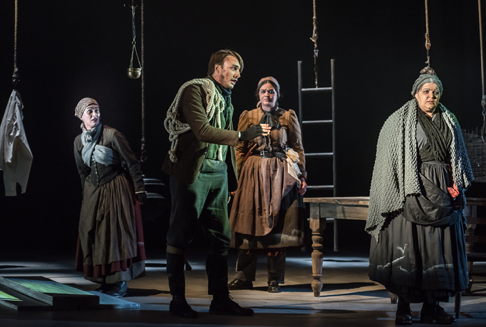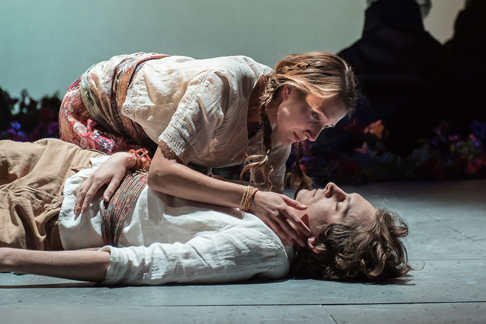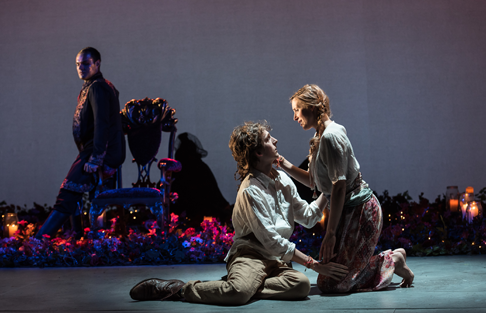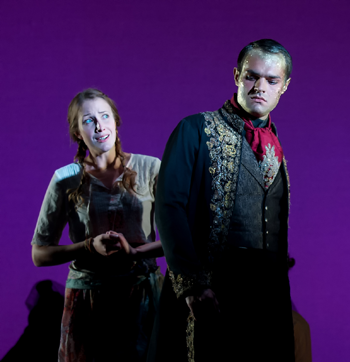![Scene from Riders to the Sea [Photo by Clive Barda]](http://www.operatoday.com/Riders-Press-4-%28Barda%29-.png)
14 Sep 2015
Vaughan Williams and Holst Double Bill
One is a quasi-verbatim rendering of J.M. Synge’s bleak tale of a Donegal family’s fateful dependency on and submission to the deathly power of the sea.
English Touring Opera are delighted to announce a season of lyric monodramas to tour nationally from October to December. The season features music for solo singer and piano by Argento, Britten, Tippett and Shostakovich with a bold and inventive approach to making opera during social distancing.
This tenth of ten Live from London concerts was in fact a recorded live performance from California. It was no less enjoyable for that, and it was also uplifting to learn that this wasn’t in fact the ‘last’ LfL event that we will be able to enjoy, courtesy of VOCES8 and their fellow vocal ensembles (more below …).
Ever since Wigmore Hall announced their superb series of autumn concerts, all streamed live and available free of charge, I’d been looking forward to this song recital by Ian Bostridge and Imogen Cooper.
Although Stile Antico’s programme article for their Live from London recital introduced their selection from the many treasures of the English Renaissance in the context of the theological debates and upheavals of the Tudor and Elizabethan years, their performance was more evocative of private chamber music than of public liturgy.
Evidently, face masks don’t stifle appreciative “Bravo!”s. And, reducing audience numbers doesn’t lower the volume of such acclamations. For, the audience at Wigmore Hall gave soprano Elizabeth Llewellyn and pianist Simon Lepper a greatly deserved warm reception and hearty response following this lunchtime recital of late-Romantic song.
For this week’s Live from London vocal recital we moved from the home of VOCES8, St Anne and St Agnes in the City of London, to Kings Place, where The Sixteen - who have been associate artists at the venue for some time - presented a programme of music and words bound together by the theme of ‘reflection’.
'Such is your divine Disposation that both you excellently understand, and royally entertaine the Exercise of Musicke.’
‘And there was war in heaven: Michael and his angels fought against the dragon; and the dragon fought and his angels, And prevailed not; neither was their place found any more in heaven … that old serpent … Satan, which deceiveth the whole world: he was cast out into the earth, and his angels were cast out with him.’
There was never any doubt that the fifth of the twelve Met Stars Live in Concert broadcasts was going to be a palpably intense and vivid event, as well as a musically stunning and theatrically enervating experience.
‘Love’ was the theme for this Live from London performance by Apollo5. Given the complexity and diversity of that human emotion, and Apollo5’s reputation for versatility and diverse repertoire, ranging from Renaissance choral music to jazz, from contemporary classical works to popular song, it was no surprise that their programme spanned 500 years and several musical styles.
The Academy of St Martin in the Fields have titled their autumn series of eight concerts - which are taking place at 5pm and 7.30pm on two Saturdays each month at their home venue in Trafalgar Square, and being filmed for streaming the following Thursday - ‘re:connect’.
The London Symphony Orchestra opened their Autumn 2020 season with a homage to Oliver Knussen, who died at the age of 66 in July 2018. The programme traced a national musical lineage through the twentieth century, from Britten to Knussen, on to Mark-Anthony Turnage, and entwining the LSO and Rattle too.
With the Live from London digital vocal festival entering the second half of the series, the festival’s host, VOCES8, returned to their home at St Annes and St Agnes in the City of London to present a sequence of ‘Choral Dances’ - vocal music inspired by dance, embracing diverse genres from the Renaissance madrigal to swing jazz.
Just a few unison string wriggles from the opening of Mozart’s overture to Le nozze di Figaro are enough to make any opera-lover perch on the edge of their seat, in excited anticipation of the drama in music to come, so there could be no other curtain-raiser for this Gala Concert at the Royal Opera House, the latest instalment from ‘their House’ to ‘our houses’.
"Before the ending of the day, creator of all things, we pray that, with your accustomed mercy, you may watch over us."
The doors at The Metropolitan Opera will not open to live audiences until 2021 at the earliest, and the likelihood of normal operatic life resuming in cities around the world looks but a distant dream at present. But, while we may not be invited from our homes into the opera house for some time yet, with its free daily screenings of past productions and its pay-per-view Met Stars Live in Concert series, the Met continues to bring opera into our homes.
Music-making at this year’s Grange Festival Opera may have fallen silent in June and July, but the country house and extensive grounds of The Grange provided an ideal setting for a weekend of twelve specially conceived ‘promenade’ performances encompassing music and dance.
There’s a “slide of harmony” and “all the bones leave your body at that moment and you collapse to the floor, it’s so extraordinary.”
“Music for a while, shall all your cares beguile.”
The hum of bees rising from myriad scented blooms; gentle strains of birdsong; the cheerful chatter of picnickers beside a still lake; decorous thwacks of leather on willow; song and music floating through the warm evening air.
![Scene from Riders to the Sea [Photo by Clive Barda]](http://www.operatoday.com/Riders-Press-4-%28Barda%29-.png)
One is a quasi-verbatim rendering of J.M. Synge’s bleak tale of a Donegal family’s fateful dependency on and submission to the deathly power of the sea.
The other is a setting of an episode from the epic Indian poem, the Mahābhārata, in which a wife defies Death and restores her husband to life. At first glance, the two works which formed British Youth Opera’s imaginative double bill of early-twentieth century one-act English operas appear to be geographically and thematically disparate. However, as director Rodula Gaitanou’s thoughtful productions elucidated, they are bound together by their explorations of death and grief within specific cultural contexts.
Moreover, both operas possess little dramatic development and rely considerably on setting, lighting, design, movement and stage-craft to communicate their ‘message’ with power and clarity to the audience. Set designer Simon Bejer and, especially, lighting designer David Howe made significant and impressive contributions to each of these productions.
 A scene from Riders to the Sea
A scene from Riders to the Sea
Riders to the Sea — written in 1927 and first performed 10 years later —is a sort of Irish predecessor to Peter Grimes: while Britten’s ambiguous fisherman does not have a parallel in Synge’s depiction of a west coast town which is simultaneously beholden to the fitful generosity of the Atlantic and helplessly exposed to the ocean’s natural violence, Britten’s desire (expressed in his written Introduction to Peter Grimes) to, ‘express my awareness of the perpetual struggle of men and women whose livelihood depends on the sea’ is embodied in the desperation, desolation and melancholy — and ultimate resignation — of Synge’s beleaguered characters.
It is no surprise that the composer of the Pastoral Symphony and Sinfonia antartica was drawn to the tragic tale of man’s battle for survival in the face of a hostile Nature; nor that, as a Christian humanist, Vaughan Williams was struck by the resignation and faith of those who believe that there can be, and should be, no resistance against a God who is ultimately benevolent.
Riders to the Sea was based on stories that Synge had collected when living in the Aran Islands, to whence he had ‘retreated’ in order to nurture his commitment to an Irish regeneration based upon creativity and culture, rather than politics and violent protest. Maurya, a fisherman's widow, is the central consciousness of the play, and of Vaughan Williams’ opera. It is her tragedy: the sea has taken her father-in law, her husband and four sons from her; now a fifth, Michael, is missing and her youngest son, Bartleby, attracted by the appeal of the Connemara fair, wishes to travel to Galway by boat. Maurya pleads with him, with harsh words, to remain; when he refuses, Mauyra in convinced by her daughter Cathleen that she should ensure Bartleby parts on good terms with his family, but before Maurya can now give her blessing she is afflicted by a terrible dream in which Bartleby rides away shadowed by Michael on a grey pony, and she is convinced that this is a portent of tragedy. Sure enough, news soon comes of Michael’s drowning and of Bartleby’s fatal fall. Now, she has nothing more to lose; she is safe from the sea’s hunger and anger, and adopts a stoic resignation to her heart-breaking misfortunes.
 A scene from Sāvitri
A scene from Sāvitri
Simon Bejer’s set communicated much through economical means, giving us both a naturalistic domestic world — a sparse home, equipped with spinning wheel, wooden table and, hanging from ropes which intimated the coastal locale, a stove, bucket, shirt, muslin bag — and a dream-like vision of the sea’s dark depths, with Maurya’s lost men-folk seated, facing outwards, around a circular bench, bound by the nets that they are mending. David Howe illuminated the dual world from above, shining spots — like search-lights — down into the blue-green deep, creating eerie dapples and shadows, and suggesting the exposure of the community to higher ‘powers’.
Claire Barnett-Jones was terrific as Maurya. With her first entry, the contrast between her focused yet soulful contralto and the soprano voices of her daughters, Cathleen and Nora, was telling. Vaughan Williams sets Synge’s words in declamatory fashion, following the intonation and inflections of the playwright’s Hiberno-English meticulously (Synge employed the English dialect of Ireland, to reinforce its literary potential) but this can result in limited melodic character and monotony, and make it difficult (particularly so in the absence of sur-titles to discern the details of the text).
However, Barnett-Jones’ declamation was grave and transfixing, taking us compellingly through the inexorable journey, and submission, to death; she sustained the vocal and dramatic intensity through her long monologues, and her words upon the death of Bartleby —‘May the Almighty God have mercy on Bartley's soul … and on the soul of everyone left living in the world’ — were shocking in their candid acceptance of fate and passive forbearing. Barnett-Jones makes her Wigmore Hall debut next year, and is clearly a young singer to watch. As her daughters, Josephine Goddard (Cathleen) and Harriet Eyley (Nora) completed the household of feminine suffering; Eyley in particular demonstrated an appealing brightness and vigour. These soloists were complemented by a strong female chorus whose wordless prayer of mourning was moving. Huw Montague Rendall was the sole male soloist and though his baritone was a little ‘raw’ this was perhaps not dramatically inappropriate and his Bartleby was a haunting presence.
 A scene from Sāvitri
A scene from Sāvitri
The trouble with Riders to the Sea, though is that Vaughan Williams’ respectful — overly reverential? — approach to Synge’s text means that it is not the music that defines the ‘meaning’ of the opera. Synge’s text calls the tune, and the music further applies the brakes: the melodic lines can seem as lacking in life as Maurya’s deceased menfolk. Musically, only Maurya is ‘three-dimensional’, and powerful stagecraft is need if the drama, rather than the emotions felt by Maurya, is to be credibly recreated. (One can, however, imagine Riders working well on the radio.) Alongside Howe’s captivating lighting there was some absorbing stagecraft: the ‘resurrection’ of Michael from the kitchen table over which his mother and sisters mourn, and his slow walk to take his place among the circle of drowned kinsmen, were arresting and affecting. But, rather than create drama from within, Gaitanou often imposed it from without, through an overly intrusive ‘Sea Machine’ (which the composer did include in the orchestral forces), for example, and through invasive sobbing at the close. Silence would surely have been more ‘truthful’.
Conductor Geoffrey Paterson worked hard at the start to communicate the violent force of the composer’s clashing dissonances, the polyphonic voices of the instrumentalists of the Southbank Sinfonia speaking penetratingly. But, Paterson was less successful in the latter stages of the score, where it is the ‘vertical’ shifts and surges of harmony (recalling the Tallis Fantasia)which should communicate the emotional unrest and agony of the bereaved, as well as the merciless welling of the sea.
 A scene from Sāvitri
A scene from Sāvitri
Written between 1908 and 1909, and first performed in 1916, Holst’s Sāvitri lasts just 30 minutes and is written for three singers supported by a small ensemble of two flutes, cor anglais, double string quartet, and double-bass. The original Mahābhārata tale upon which the opera is based, effectively reverses Synge’s portrayal of feminine resignation: the Indian myth tells of the beautiful princess Sāvitri’s refusal to accept that Death should be permitted to take her husband, Satyavān — a woodcutter and son of a dispossessed king, whom she has married despite being informed by the sage Narada that Satyavān, who is unaware of his fate, has just one year to live. When the fateful day arrives, Satyavān falls dead while out cutting wood: Sāvitri challenges Death (Yama), and the latter, recognising her extraordinary lack of fear of him, grants her five boons, and she tricks Death thereby enabling her husband to return to life.
Holst set only the central episode, the confrontation with Death. And, at heart his opera is not really about Death, but rather concerned with Life. Replying to one of Death’s questions, Sāvitri explains that ‘life is communion, each one that liveth, liveth for all’, continuing ‘life is eternal’ and ‘urges us on till time and space are forgot and joy and sorrow are one’ — sentiments which remind us of Holst’s interest in ideologies of William Morris and of Walt Whitman.
Holst also excised all references to Hinduism, making the story more universal. Gaitanou and Bejer, however, to some extent restore the specific cultural and religious context, with warm lighting painting the stage in swathes of yellow, ochre, orange and maroon — penetrated by dark silhouettes and shadows — and a carpet of flickering candles placed amid festive flowers, upon which rests Death’s throne, evoking Diwali, the Festival of Lights.
Holst’s melodic writing is more distinctive and expressive than Vaughan Williams’ undemonstrative declamation but Sāvitri suffers from a similar absence of sustained dramatic action and momentum. Mezzo soprano Sofia Larsson sang accurately and cleanly, but lacked the weight and variety of hue to carry the drama forward. Her confrontations with Matt Buswell’s Death were engaging however, and she captured Sāvitri’s fortitude in the face of exposure to supra-human forces. Buswell’s control of line and intonation was a little wayward at times (Death’s music is more harmonically unstable than the essentially modal clarity of the lovers’ melodies), but he communicated with directness. Adam Temple-Smith’s appealing tenor emphasised Satyavān’s sincerity and vulnerability, and he coped admirably with the high lying passages, although his diction was not always clear. Geoffrey Paterson again drew fine playing from the players of the Southbank Sinfonia; solos by the viola and cello were especially touching.
Hats off to British Youth Opera for these adventurous and brave productions; they illuminated surprising relationships between the two seldom performed works and showcased some fine young talent.
Claire Seymour
Casts:
Vaughan Williams: Riders to the Sea
Nora — Harriet Eyley, Cathleen — Josephine Goddard, Maurya — Claire Barnett-Jones, Bartley Huw Montague — Rendall, A Woman — Beth Moxon, Chorus (Hannah Bennett, Susanna Buckle, Sian Griffiths, Emily Kyte, Polly Leech, Lauren Morris, Beth Moxon, Rebecca Silverman, Rebekah Smith, Victoria Songwei Li, Rachel Wolseley, Catherine Wood; with Glen Cunningham, Christopher Dollins, Richard Moore, Kenneth Reid, Martins Smaukstelis, Harry Thatcher, Joel Williams)
Holst: Sāvitri
Death — Matt Buswell, Sāvitri — Sofia Larsson, Satyavān — Adam Temple-Smith, Chorus (Hannah Bennett, Susanna Buckle, Heulen Cynfal, Sian Griffiths, Emily Kyte, Polly Leech, Lauren Morris, Beth Moxon, Rebekah Smith, Victoria Songwei Li, Rachel Wolseley, Catherine Wood; with Glen Cunningham, Christopher Dollins, Milo Harries, Richard Moore, Kenneth Reid, Martins Smaukstelis, Harry Thatcher)
Production Team:
Director — Rodula Gaitanow, Conductor — Geoffrey Paterson, Set Designer — Simon Bejer, Lighting Designer — David Howe, Costume Designer — Laura Jane Stanfield, Movement Director — Mandy Demetriou, Vocal Coach — Mary Hegarty. British Youth Opera, Peacock Theatre, London, Wednesday, 10th September 2015.